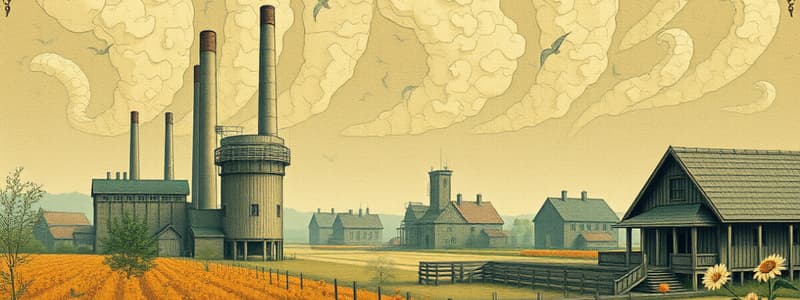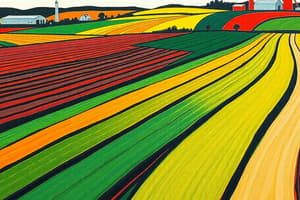Podcast
Questions and Answers
How did the crop rotation system that developed in Britain during the agricultural revolution increase crop yields?
How did the crop rotation system that developed in Britain during the agricultural revolution increase crop yields?
It increased nutrients in the soil.
What were the factors of production present in Britain that encouraged the industrial revolution?
What were the factors of production present in Britain that encouraged the industrial revolution?
Land, labor, and capital.
By the late 1700s, the best place to find a water frame and a spinning mule was in?
By the late 1700s, the best place to find a water frame and a spinning mule was in?
A factory.
In the 1700s, the process of enclosure tended to increase?
In the 1700s, the process of enclosure tended to increase?
An entrepreneur is a type of?
An entrepreneur is a type of?
What were some results of the Agricultural Revolution?
What were some results of the Agricultural Revolution?
Which of the following was the first area to undergo major industrialization?
Which of the following was the first area to undergo major industrialization?
What did NOT improve as an early result of the Industrial Revolution?
What did NOT improve as an early result of the Industrial Revolution?
What group benefited the most from the Industrial Revolution in the short term?
What group benefited the most from the Industrial Revolution in the short term?
What group benefited the least from the Industrial Revolution in the short term?
What group benefited the least from the Industrial Revolution in the short term?
What did NOT improve as a result of the Industrial Revolution?
What did NOT improve as a result of the Industrial Revolution?
What did NOT increase as an early result of the Industrial Revolution?
What did NOT increase as an early result of the Industrial Revolution?
What specifically does the Industrial Revolution refer to and how did it generally spread?
What specifically does the Industrial Revolution refer to and how did it generally spread?
Why did the Industrial Revolution first begin in England rather than in other European countries?
Why did the Industrial Revolution first begin in England rather than in other European countries?
What industry or business was first transformed by the Industrial Revolution, and how?
What industry or business was first transformed by the Industrial Revolution, and how?
What was the importance of James Watt's development of a more efficient steam engine?
What was the importance of James Watt's development of a more efficient steam engine?
What changes to transportation took place during the Industrial Revolution and how did they influence life and society in England?
What changes to transportation took place during the Industrial Revolution and how did they influence life and society in England?
Study Notes
Agricultural Revolution and Crop Yields
- The crop rotation system developed in Britain enhanced soil nutrients, significantly increasing crop yields.
Factors of Production in Britain
- Natural resources like water power, coal, iron ore, rivers, and harbors were available.
- A large population provided abundant labor.
- A stable banking system facilitated investment in machinery and business ventures.
- Legislative support from Parliament encouraged business development.
Industrial Advancements
- Water frames and spinning mules were primarily housed in factories by the late 1700s.
- The enclosure movement increased farming efficiency, leading to larger, more productive farms.
Role of Entrepreneurs
- Entrepreneurs played a pivotal role in the economic landscape as businesspeople that contributed to industrial growth.
Outcomes of Agricultural Revolution
- Many small farmers transitioned to tenant farming or migrated to urban areas.
- Wealthy landowners established enclosures as symbols of prosperity, innovating agricultural techniques.
- Food prices fell, leading to increased population and larger farm sizes.
Textile Industry and Industrialization
- Textile production was the first sector to experience significant industrialization.
- Early factory conditions were harsh, failing to improve worker welfare despite increased production.
Social Impact of the Industrial Revolution
- Entrepreneurs benefitted the most in the short term, gaining wealth and prestige as part of the emerging middle class.
- Poor children suffered the most, enduring dangerous working conditions with long hours and low pay.
Environmental Impact
- The Industrial Revolution did not improve environmental preservation efforts, leading to ecological degradation.
Life Expectancy
- Average worker life expectancy did not increase in the early stages of the Industrial Revolution.
Definition and Spread of the Industrial Revolution
- The Industrial Revolution marks the rise of machine-made goods starting in mid-1700s England.
- It subsequently spread to mainland Europe and North America.
Reasons for England's Leadership in Industrialization
- England's significant population of skilled workers and rich natural resources fostered early industrial development.
- A robust economy combined with a stable banking system facilitated investment and innovation.
Transformations in Textile Industry
- The textile industry was revolutionized with innovations like the "flying shuttle," "spinning jenny," and "spinning mule," enhancing productivity.
James Watt and the Steam Engine
- James Watt created a more efficient steam engine, which sped up industrial processes and reduced fuel consumption.
- His enhancements facilitated the transportation of raw materials and finished goods.
Transportation Innovations
- The advent of steam-powered transportation led to the construction of canals and improved road networks.
- Railroads emerged, providing affordable transport options and creating numerous jobs, spurring further industrial growth in England.
Studying That Suits You
Use AI to generate personalized quizzes and flashcards to suit your learning preferences.
Description
This quiz covers key concepts from Unit 3 about the Industrial Revolution, including crop rotation and factors of production in Britain. Test your knowledge with flashcards that encapsulate important definitions and ideas relevant to this transformative period in history.



